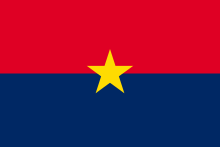Chinese Peasants' and Workers' Democratic Party
Chinese Peasants' and Workers' Democratic Party 中国农工民主党 Zhōngguó Nónggōng Mínzhǔdǎng | |
|---|---|
 Flag of Fujian People's Government built by Productive People's Party, predecessor of CPWDP. | |
| Chairperson | Chen Zhu |
| Founded | November 1927, formally in 9 August 1930[1] |
| Preceded by | Productive People's Party |
| Headquarters | Beijing |
| Newspaper |
Qianjin Luntan(Forum For Advancement)[2] Medicine & Health Care Daily[3] |
| Membership | 145,000[4] |
| Ideology |
Socialism with Chinese characteristics Xi Jinping Thought Chinese unification Nationalism Progressivism New Democracy[5][1] |
| Political position | Left-wing |
| National affiliation | United Front |
| National People's Congress |
89 / 2,987 |
| Standing Committee of NPC |
6 / 166 |
| State Administrations and Bureaus under ministry-level agencies |
2 / 17 |
| Website | |
| Official Site | |
| Chinese Peasants' and Workers' Democratic Party | |||||||||
| Chinese name | |||||||||
|---|---|---|---|---|---|---|---|---|---|
| Simplified Chinese | 中国农工民主党 | ||||||||
| Traditional Chinese | 中國農工民主黨 | ||||||||
| |||||||||
| Abbreviation | |||||||||
| Chinese | 农工党 | ||||||||
| |||||||||
| Tibetan name | |||||||||
| Tibetan | ཀྲུང་གོ་ཞིང་བཟོ་དམངས་གཙོ་ཏང | ||||||||
| |||||||||
| Zhuang name | |||||||||
| Zhuang | Cunghgoz Nungzgungh Minzcuj Danj | ||||||||
| Mongolian name | |||||||||
| Mongolian Cyrillic | Дундад улсын тариачны-ажилчин ардчилсан нам | ||||||||
| Mongolian script |
ᠳᠤᠮᠳᠠᠳᠤ ᠤᠯᠤᠰ ᠤᠨ ᠲᠠᠷᠢᠶᠠᠴᠢᠨ ᠤ ᠠᠵᠢᠯᠴᠢᠨ ᠠᠷᠠᠳᠴᠢᠯᠠᠭᠰᠠᠨ ᠨᠠᠮ | ||||||||
| Uyghur name | |||||||||
| Uyghur |
جۇڭگو دېھقان-ئىشچىلار دېموكراتىك پارتىيىسى | ||||||||
| |||||||||
| Manchu name | |||||||||
| Manchu script | ᠨᠣᠩᡬᠣᠩᡩᠠᠩ | ||||||||
| Romanization | Nongg'ongdang | ||||||||
The Chinese Peasants' and Workers' Democratic Party (Chinese: 中国农工民主党) is one of the eight non-communist, legally recognised political parties in the People's Republic of China that follow the direction of the Communist Party of China and is a member of the Chinese People's Political Consultative Conference. The current chairman is former Minister of Health Chen Zhu.
History
Foundation
The party had its origins in the collapse of the First United Front when they first met on November 1927. Its original members were left-wing Nationalists and expelled Communists which called themselves the "Provisional Action Committee of the Chinese Nationalist Party" or "Third Party" (despite the name, the Young China Party was third largest in the late 1920s–40s).
After August 1930, the party became a cohesive entity under Deng Yanda, who organized it under democratic centralism like both the Nationalists and Communists. Deng was secretly executed by Chiang Kai-shek in 1931 and the party went underground.
In 1933, the party, now led by Huang Qixiang, joined with the short-lived "Productive People's Party" in starting the failed People's Revolutionary Government of the Republic of China. In 1935, they renamed themselves in to the "Chinese Action Committee for National Liberation". It was one of the founding parties of the China Democratic League. Its leaders renamed the party in February 1947 to its current name.
Present
Currently, the Chinese Peasants' and Workers' Democratic Party comprises a membership of 144,000, most of whom work in the fields of public health, culture and education, science and technology.
Chairpersons
- Deng Yanda (邓演达) (1930–1931)
- Huang Qixiang (黄琪翔) (1931–1938)
- Zhang Bojun (章伯钧) (1938–1958)
- Ji Fang (季方) (1958–1987)
- Zhou Gucheng (周谷城) (1987–1988)
- Lu Jiaxi (卢嘉锡) (1988–1997)
- Jiang Zhenghua (蒋正华) (1997–2007)
- Sang Guowei (桑国卫) (2007–2012)
- Chen Zhu (陈竺) (2012 – present)[6]
References
- 1 2 "中国农工民主党章程(第十五次全国代表大会通过)_历次党章_中国农工民主党". www.ngd.org.cn.
- ↑ "党刊撷英_中国农工民主党". www.ngd.org.cn.
- ↑ "《医药养生保健报》唯一官网——医药健康网". www.fv88.com.
- ↑ "简介_中国农工民主党". www.ngd.org.cn.
- ↑ "中国农工民主党党章(第四次全国干部会议通过)_历次党章_中国农工民主党". www.ngd.org.cn.
- ↑ "本届领导_中国农工民主党". www.ngd.org.cn.
External links
- Official website (in Chinese)